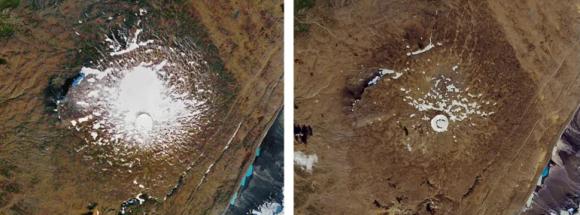
The shrinking of the Okjökull glacier from Sept. 14, 1986 (left) to Aug. 1, 2019.
Photo: NASA (AP)
The Okjökull glacier, northeast of Reykjavik, was known simply as Ok to Icelanders. (In Icelandic, jökull means glacier.) In 1890, Ok’s ice covered 16sq km (6.2 square miles) but by 2012 it measured just 0.7sq km, according to a report from the University of Iceland in 2017. Now, it is effectively gone.
Iceland loses about 11bn tonnes of ice per year, and scientists fear all of the island’s 400-plus glaciers will be gone by 2200, according to Cymene Howe, associate professor at Rice University in Texas. Glaciers cover about 11% of the country’s surface.
Iceland has chosen to memorialize the first glacier lost to climate change with a plaque which reads:
Ok is the first Icelandic glacier to lose its status as glacier.
In the next 200 years, all our glaciers are expected to follow the same path.
This monument is to acknowledge that we know
what is happening and know what needs to be done.
Only you know if we did it.
August 2019
415ppm CO2
Iceland, of course, is not alone in experiencing the impact of climate change. CNN reports that this July alone, Greenland’s ice sheet lost 197 billion tons of ice. On last Thursday alone, it lost a record 11 billion tons of surface ice to the ocean, the biggest melt of the summer.
Greenland’s ice sheet is the second biggest in the world and this season’s ice melt has already contributed around half a millimeter to global sea levels.
Thanks to Irwin Bryan for contributing to this post.

Greenland’s similar situation is worthy of note.
Please see – https://www.scientificamerican.com/article/what-greenland-might-have-taught-trump-about-warming/
And – https://edition.cnn.com/videos/world/2019/08/19/nasa-greenland-climate-battle-pleitgen-pkg.cnn
Etc.